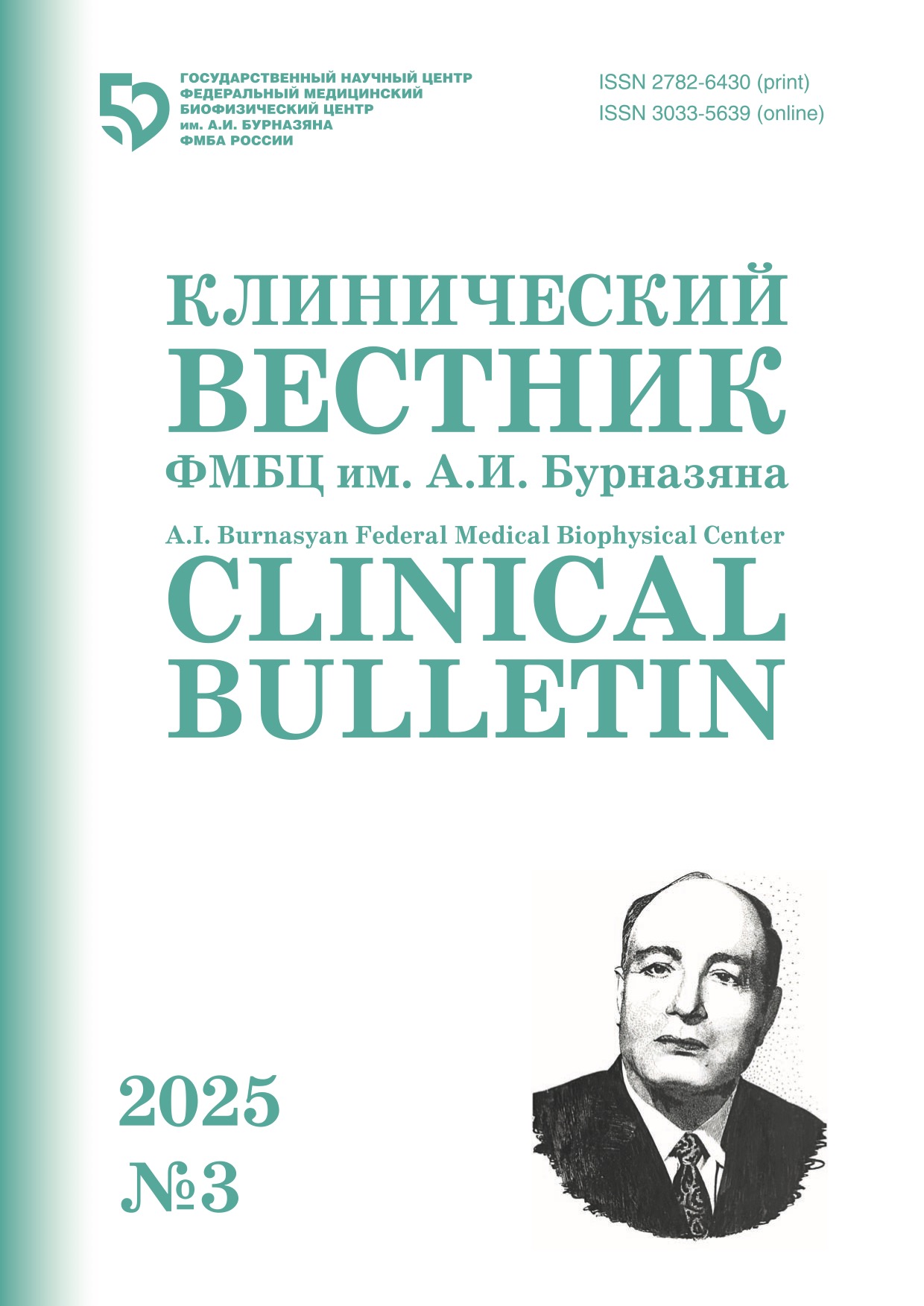A.I. Burnasyan FMBC clinical bulletin. 2023 № 4
E.A. Praskurnichiy1, A.A. Zolotareva2, O.S. Orlova1, N.B. Pavlov1
Dynamics of Depressive and Psychosomatic Symptoms with Hyperbaric Oxygenation
in Therapy of Patients with Long COVID-19
1International Office, State Research Center – Burnasyan Federal Medical Biophysical Center of Federal Medical Biological Agency, Moscow, Russiа
2HSE University, Moscow, Russiа
Contact person: Zolotareva Alena Anatol’evna: alena.a.zolotareva@gmail.com
Abstract
Purpose: To examine the dynamics of depressive and psychosomatic symptoms with hyperbaric oxygenation in therapy of patients with long COVID-19.
Material and Methods: Patients with long COVID-19 (n = 52) who underwent 15 sessions of hyperbaric oxygenation in the Polyclinic No. 2 of the Federal State Budgetary Institution Federal Medical and Biological Center of Russia completed the Giessen questionnaire for self-assessment of psychosomatic symptoms before and after therapy. The patient depressive symptoms were also assessed before and after therapy by psychiatrists using the Hamilton Rating Scale for Depression.
Results: The results showed a decrease in depressive symptoms, exhaustion, gastric and cardiac complaints, and overall symptom pressure after hyperbaric oxygen therapy. Rheumatic factor appeared to be the only psychosomatic symptom that did not decrease after therapy.
Conclusion: Overall, depressive and psychosomatic symptoms are persistent with long COVID-19, and hyperbaric oxygenation may be effective in treating this symptomatology.
Keywords: depression, hyperbaric oxygenation, long COVID-19, psych osomatic sym
For citation: Praskurnichiy EA, Zolotareva AA, Orlova OS, Pavlov NB. Dynamics of Depressive and Psychosomatic Symptoms with Hyperbaric Oxygenation in Therapy of Patients with Long COVID-19. A.I. Burnasyan Federal Medical Biophysical Center Clinical Bulletin. 2023.4:26-30. (In Russian) DOI: 10.33266/2782-6430-2023-4-26-30
REFERENCES
- Huang S, Zhuang W, Wang D, Zha L, Xu X, Li X, Xhi Q, Wang XS, Guibin Q. Persistent somatic symptom burden and sleep disturbance in patients with COVID-19 during hospitalization and after discharge: A prospective cohort study. Medical Science Monitor. 2021;27:e930447. https://doi.org/10.12659/MSM.930447
- Kersten J, Wolf A, Hoyo L, Hüll E, Tadic M, Andreß S, d’Almeida S, Scharnbeck D, Roder E, Beschoner P, Rottbauer W, Buckert D. Symptom burden correlates to impairment of diffusion capacity and exercise intolerance in long COVID patients. Scientific Reports. 2022;12:8801. https://doi.org/10.1038/s41598-022-12839-5
- Bottemanne H, Gouraud C., Hulot J-S, Blanchard A, Ranque B, Lahlou-Laforêt K, Limosin F, Günther S, Lebeaux D, Lemogne C. Do anxiety and depression predict persistent physical symptoms after a severe COVID-19 episode? A prospective study. Frontiers in Psychiatry. 2021;12:757685. https://doi.org/10.3389/fpsyt.2021.757685
- Ezzelregal HG, Hassan AM, Mohamed RS, Ahmed NO. Post-COVID depression among a sample of Egyptian patients and its associated factors. Egyptian Journal of Bronchology. 2021;15:44. https://doi.org/10.1186/s43168-021-00086-7
- Bueno-Notivol J, Gracia-García P, Olaya B, Lasheras I, López-Antón R, Santabárbara J. Prevalence of depression during the COVID-19 outbreak: A meta-analysis of community-based studies. International Journal of Clinical and Health Psychology. 2021;21(1):100196. https://doi.org/10.1016/j.ijchp.2020.07.007
- Balakrishnan V, Ng KS, Kaur W, Govaichelvan K, Lee ZL. COVID-19 depression and its risk factors in Asia Pacific – A systematic review and meta-analysis. Journal of Affective Disorders. 2022;298:47-56. https://doi.org/10.1016/j.jad.2021.11.048
- Kim SW, Park IH, Kim M, Park A-L, Jhon M, Kim J-W, Kang H-J, Ryu S, Lee J-Y, Kim J-M. Risk and protective factors of depression in the general population during the COVID-19 epidemic in Korea. BMC Psychiatry. 2021;21: 445. https://doi.org/10.1186/s12888-021-03449-y
- Rutland-Lawes J, Wallinheimo A-S, Evans SL. Risk factors for depression during the COVID-19 pandemic: A longitudinal study in middle-aged and older adults. BJPsych Open. 2021:7(5):161. https://doi.org/10.1192/bjo.2021.997
- Renaud-Charest O, M W Lui LMW, Eskander S, Ceban F, Ho R, Di Vincenzo JD, Rosenblat JD, Lee Y, Subramaniapillai M, McIntyre RS. Onset and frequency of depression in post-COVID-19 syndrome: A systematic review. Journal of Psychiatric Research. 2021;144:129-137. https://doi.org/10.1016/j.jpsychires.2021.09.054
- Vassalini P, Serra R, Tarsitani L, Koukopoulos AE, Borrazzo C, Alessi F, Di Nicolantonio C, Tosato C, Alessandri F, Ceccarelli G, Mastroianni CM, d’Ettorre G. Depressive symptoms among individuals hospitalized with COVID-19: Three-month follow-up. Brain Sciences. 2021;11(9):1175. https://doi.org/10.3390/brainsci11091175
- Bhaiyat AM, Sasson E, Wang Z, Khairy S, Ginzarly M, Qureshi U, Fikree M, Efrati S. Hyperbaric oxygen treatment for long coronavirus disease-19: A case report. Journal of Medical Case Reports. 2022;16:80. https://doi.org/10.1186/s13256-022-03287-w
- Robbins T, Gonevski M, Clark C, Baitule S, Sharma K, Magar A, Patel K, Sankar S, Kyrou I, Ali A, Randeva HS. Hyperbaric oxygen therapy for the treatment of long COVID: early evaluation of a highly promising intervention. Clinical Medicine. 2021;21(6):629-632. https://doi.org/10.7861/clinmed.2021-0462
- Brähler E, Hinz A, Scheer JW. GBB-24. Der Gießener Beschwerdebogen Manual. 3rd edition. Bern: Huber; 2008.
- Hamilton M. A rating scale for depression. Journal of Neurology, Neurosurgery, and Psychiatry. 1960;23(1), 56-62. https://doi.org/10.1136/jnnp.23.1.56
- Sapkota HR, Nune A. Long COVID from rheumatology perspective – a narrative review. Clinical Rheumatology. 2022;41(2):337-348. https://doi.org/10.1007/s10067-021-06001-1
- Медведев В.Э., Фролова В.И., Гушанская Е.В., Котова О.В., Зуйкова Н.Л., Палин А.В. Астенические расстройства в рамках постковидного синдрома. Журнал неврологии и психиатрии им. С.С. Корсакова. 2021;121(4):152‑158. [Medvedev VE, Frolova VI, Gushanskaya EV, Kotova OV, Zuikova NL, Palin AV. Astenic disorders within the framework of post-covid syndrome. Zhurnal Nevrologii i Psikhiatrii imeni S.S. Korsakova. 2021;121(4):152‑158. (In Russ.)] https://doi.org/10.17116/jnevro2021121041152
- Biagianti B, Zito S, Fornoni C, Ginex, V., Bellani, M., Bressi, C., & Brambilla, P. Developing a brief tele-psychotherapy model for COVID-19 patients and their family members. Frontiers in Psychology. 2021;12:784685. https://doi.org/10.3389/fpsyg.2021.784685
Conflict of interest. The authors declare no conflict of interest.
Financing. The study had no sponsorship.
Contribution. Article was prepared with equal participation of the authors.
Article received: 05.10.2023. Accepted for publication: 08.11.2023


